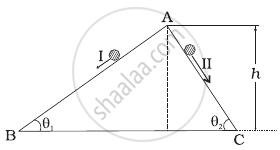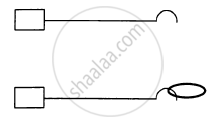Advertisements
Advertisements
प्रश्न
Two inclined frictionless tracks, one gradual and the other steep meet at A from where two stones are allowed to slide down from rest, one on each track as shown in figure.

Which of the following statement is correct?
पर्याय
Both the stones reach the bottom at the same time but not with the same speed.
Both the stones reach the bottom with the same speed and stone I reaches the bottom earlier than stone II.
Both the stones reach the bottom with the same speed and stone II reaches the bottom earlier than stone I.
Both the stones reach the bottom at different times and with different speeds.
उत्तर
Both the stones reach the bottom with the same speed and stone II reaches the bottom earlier than stone I.
Explanation:
As seen in the diagrams, AB and AC are two smooth planes inclined at the angles θ1 and θ2, respectively.
Because there is no friction here, mechanical energy will be preserved.
Because both tracks have the same height h,
`1/2 mv^2 = mg`
`hv = sqrt(2gh)`
Hence, speed is the same for both stones. For stone I, a1 = acceleration along the inclined plane = g sin θ1
Similarly, for stone II, a2 = g sin θ2
And because track II is shorter in length, stone II arrives earlier than stone I.
APPEARS IN
संबंधित प्रश्न
A heavy stone is thrown from a cliff of height h with a speed v. The stoen will hit the ground with maximum speed if it is thrown
A heavy stone is thrown in from a cliff of height h in a given direction. The speed with which it hits the ground
(a) must depend on the speed of projection
(b) must be larger than the speed of projection
(c) must be independent of the speed of projection
(d) may be smaller than the speed of projection.
Figure shows a particle sliding on a frictionless track which terminates in a straight horizontal section. If the particle starts slipping from point A, how far away from the track will the particle hit the ground?

One end of a spring of natural length h and spring constant k is fixed at the ground and the other is fitted with a smooth ring of mass m which is allowed to slide on a horizontal rod fixed at a height h (following figure). Initially, the spring makes an angle of 37° with the vertical when the system is released from rest. Find the speed of the ring when the spring becomes vertical.

Figure following shows a light rod of length l rigidly attached to a small heavy block at one end and a hook at the other end. The system is released from rest with the rod in a horizontal position. There is a fixed smooth ring at a depth h below the initial position of the hook and the hook gets into the ring as it reaches there. What should be the minimum value of h so that the block moves in a complete circle about the ring?

A particle is released from height S from the surface of the Earth. At a certain height, its kinetic energy is three times its potential energy. The height from the surface of the earth and the speed of the particle at that instant are respectively ______.
Which of the diagrams shown in figure represents variation of total mechanical energy of a pendulum oscillating in air as function of time?
In a shotput event an athlete throws the shotput of mass 10 kg with an initial speed of 1 ms–1 at 45° from a height 1.5 m above ground. Assuming air resistance to be negligible and acceleration due to gravity to be 10 ms–2, the kinetic energy of the shotput when it just reaches the ground will be ______.
A body falls towards earth in air. Will its total mechanical energy be conserved during the fall? Justify.
A baloon filled with helium rises against gravity increasing its potential energy. The speed of the baloon also increases as it rises. How do you reconcile this with the law of conservation of mechanical energy? You can neglect viscous drag of air and assume that density of air is constant.
